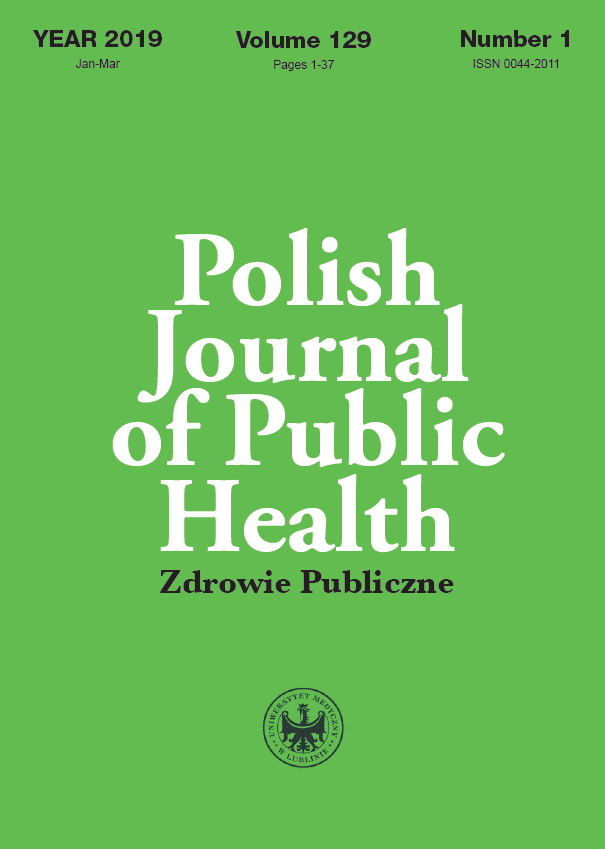Dietary preferences and health status of tobacco smokers in Poland
DOI:
https://doi.org/10.2478/pjph-2019-0003Keywords:
tobacco smokers, dietary preferences, tobacco-related diseasesAbstract
The dietary preferences can enhance or reduce negative consequences of tobacco smoking. Thus, the smoking behavior and dietary habits of 99 patients treated against pulmonary, cardiological and gastroenterological diseases in specialist outpatient clinics in Rzeszów were analyzed. The survey questionnaire examined the relation between tobacco smoking and dietary preferences (quantity and regularity of food intake, and frequency of consumption of several foodstuffs) as well as health effects of smoking. Among the respondents, 48% were currently smoking (smokers), 16% declared themselves as formerly smoking ex-smokers) and 35% did not smoke (non-smokers). The cardiovascular and respiratory health problems were more common in smokers group, but the differences were not significant (p>0.05). Smokers’ diet was low in healthy kind of food (i.e. vegetables, fruit, dairy product, antioxidative spices) and simultaneously was abundant in meat, strong coffee and alcohol (p<0.05) compared to non-smokers. For the ex-smokers greater attention to proper diet composition was observed. Based on the obtained results nutritional guidelines have been formulated to reduce the negative effects of smoking.
References
1. WHO report on the global tobacco epidemic. Monitoring tobacco use and prevention policies. World Health Organization, Geneva, 2017. License: CC BY-NC-SA 3.0 IGO.
2. Dżugan M, Juszczyk M. Rakotwórcze substancje w dymie tytoniowym. Pol J Publ Health. 2006;116:627-30.
3. Flouris AD, Faught BE, Klentrou P. Cardiovascular disease risk in adolescent smokers: evidence of a “smoker lifestyle”. J Child Health Care 2008;12:221-31.
4. Scientific Committee on Tobacco and Health (SCOTH). Secondhand smoke: review of evidence since 1998. London: Department of Health; 2004. p. 1-28. (http://www.smokefreeengland.co.uk/files/scoth_secondhandsmoke.pdf, accessed 25 September 2017)
5. Szczygieł Ł. Uzależnienie od tytoniu. Gazeta Farmaceutyczna. 2008;4:42-4.
6. Wierzejska R, Jarosz M. Palenie tytoniu – problem zdrowotny i społeczny. Żyw Człow Metab. 2010;37(2):129-38.
7. Subar AF, Harlan LC, Mattson ME. Food and nutrient intake differences between smokers and non-smokers in the US. AJPH. 1990;80:1323-9.
8. Babicz-Zielińska E, Nazarewicz R, Polańska A. Zwyczaje żywieniowe osób palących papierosy. Żyw Człow Metab. 2003;30(1-2): 53-6.
9. Śmiechowska M. Effect of tobacco smoking on the choice of mode of nutrition and dietary behaviours – Preliminary study. Med Og Nauk Zdr. 2015;21(1):107-11.
10. Rozporządzenie Rady Ministrów z dnia 4 sierpnia 2016 r. w sprawie Narodowego Programu Zdrowia na lata 2016–2020. Dz. U. poz. 1492.
11. Williams GC, Minicucci DS, Kouides RW, et al. Self-determination, smoking, diet and health. Health Educ Res 2002;17:512-21. https://doi.org/10.1093/her/17.5.512
12. Watson JM, Scarinci IC, Klesges RC, et al. Relationships among smoking status, ethnicity, socioeconomic indicators, and lifestyle variables in a biracial sample of women. Prev Med. 2003;37:138-47.
13. Centers for disease control and prevention how tobacco smoke causes disease: the biology and behavioral basis for smoking-attributable disease. A report of the surgeon general. National center for chronic disease prevention and health promotion (US); Office on Smoking and Health (US) 2010. https://www.ncbi.nlm.nih.gov/books/NBK53017/ (assessed 16.11.2017)
14. Semeniuk W. Zwyczaje żywieniowe ludzi palących. Pol J Hum Nutr. 2007;3-4:896-902.
15. Raatz SK, Jahns L, Johnson LK, et al. Smokers report lower intake of key nutrients than nonsmokers, yet both fall short of meeting recommended intakes. Nutr Res. 2017;45:30-7.
16. Dyer AR, Elliott P, Stamler J, et al. Dietary intake in male and female smokers, ex-smokers, and never smokers: the INTERMAP study. J Hum Hypertens. 2003;17:641-54.
17. Sygnowska E, Waśkiewicz A. Sposób żywienia a postawy wobec palenia tytoniu – badanie Pol-Monica Bis. Żyw Człow Metab 2006;33(1):3-17.
18. Eiserich JP, van der Vliet A, Handelman G, et al. Dietary antioxidants and cigarette smoke-induced biomolecular damage: a complex interaction. The American Society for Clinical Nutrition. 1995;62:1490S-1500S.
19. Jain A, Agrawal BK, Varma M, Jadhav AA. Antioxidant status and smoking habits: relationship with diet. Singapore Med J. 2009;50:624-7.
20. Zondervan MC, Ocke HA, Smit JC, Seidell. Do dietary supplementary intakes of antioxidants differ with smoking status? Int J Epidemiol. 1996;25:70-9.
21. Lupton JR, Blumberg JB, L’Abbe M, et al. Nutrient reference value: non-communicable disease endpoints--a conference report. Eur J Nutr. 2016;55:S1-10.
22. Higdon JV, Delage B, Williams DE, Dashwood RH. Cruciferous vegetables and human cancer risk: epidemiologic evidence and mechanistic basis. Pharmacol Res. 2007;55:224-36.
Downloads
Published
Issue
Section
License
Copyright (c) 2019 Polish Journal of Public Health

This work is licensed under a Creative Commons Attribution-NonCommercial-NoDerivatives 3.0 Unported License.


